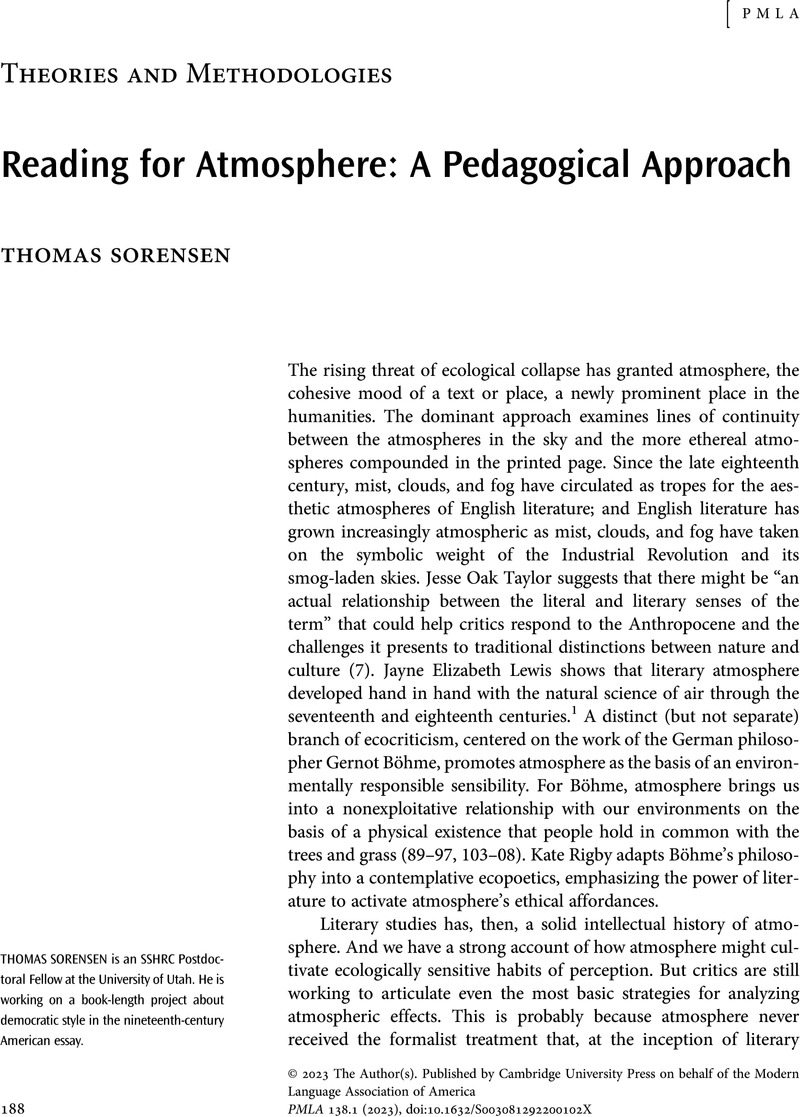No CrossRef data available.
Article contents
Reading for Atmosphere: A Pedagogical Approach
Published online by Cambridge University Press: 07 March 2023
Abstract
An abstract is not available for this content so a preview has been provided. Please use the Get access link above for information on how to access this content.

- Type
- Theories and Methodologies
- Information
- Copyright
- Copyright © 2023 The Author(s). Published by Cambridge University Press on behalf of the Modern Language Association of America
References
Works Cited
Abramson, Anna. “Joseph Conrad's Atmospheric Modernism: Enveloping Fog, Narrative Frames, and Affective Attunement.” Studies in the Novel, vol. 50, no. 3, 2018, pp. 336–58.CrossRefGoogle Scholar
Böhme, Gernot. The Aesthetics of Atmospheres. Edited by Thibaud, Jean-Paul, Routledge, 2017.Google Scholar
Böhme, Jakob. Signatura Rerum; or, The Signature of All Things: Shewing the Sign, and Signification of the Severall Forms and Shapes in the Creation and What the Beginning, Ruin, and Cure of Every Thing Is; It Proceeds out of Eternity into Time, and Again out of Time into Eternity, and Comprizeth All Mysteries. John Macock, 1651.Google Scholar
Etzi, Roberta, et al. “When Sandpaper Is ‘Kiki’ and Satin Is ‘Bouba’: An Exploration of the Associations between Words, Emotional States, and the Tactile Attributes of Everyday Materials.” Multisensory Research, vol. 29, 2016, pp. 133–55.CrossRefGoogle ScholarPubMed
Heise, Ursula. Sense of Place and Sense of Planet: The Environmental Imagination of the Global. Oxford UP, 2008.CrossRefGoogle Scholar
Lewis, Jayne Elizabeth. Air's Appearance: Literary Atmosphere in British Fiction, 1660–1794. U of Chicago P, 2012.CrossRefGoogle Scholar
Rigby, Kate. Reclaiming Romanticism: Towards an Ecopoetics of Decolonization. Bloomsbury, 2020.CrossRefGoogle Scholar
Robinson, Marilynne. “The Radiant Astonishment of Existence: Two Interviews with Marilynne Robinson, March 20, 2004 and February 9, 2007.” Conducted by George Handley and Lance Larsen. Literature and Belief, vol. 27, no. 2, 2007, pp. 113–34.Google Scholar
Robinson, Marilynne. “Wilderness.” The Death of Adam: Essays on Modern Thought, Picador, 2014, pp. 245–54.Google Scholar
Santayana, George. Essays in Literary Criticism. Edited by Singer, Irving, Scribner, 1956.Google Scholar
Stanley, Kate. Practices of Surprise in American Literature after Emerson. Cambridge UP, 2018.CrossRefGoogle Scholar
Taylor, Jesse Oak. The Sky of Our Manufacture: The London Fog in British Fiction from Dickens to Woolf. U of Virginia P, 2016.Google Scholar
Wang, Wei [王維]. 竹里館 [“Lodge in Bamboo”]. The Poetry and Prose of Wang Wei, translated by Rouzer, Paul, vol. 2, De Gruyter, 2020, p. 118.Google Scholar
Weil, Simone. Gravity and Grace. Edited by Thibon, Gustave, translated by Crawford, Emma and von der Ruhr, Mario, Routledge, 2002.Google Scholar
Woods, Andy T., et al. “Fast Lemons and Sour Boulders: Testing Crossmodal Correspondences Using an Internet-Based Testing Methodology.” i-Perception, vol. 4, 2013, pp. 365–79.CrossRefGoogle ScholarPubMed
Zhang, Dora. Strange Likeness: Description and the Modernist Novel. U of Chicago P, 2020.CrossRefGoogle Scholar




